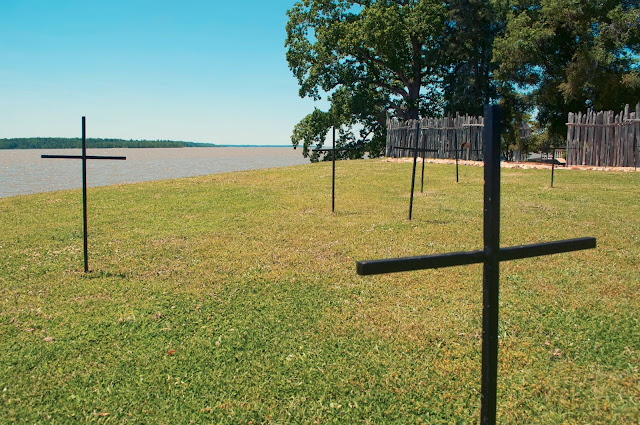YORKTOWN
The first place we visited was Yorktown.
To refresh your memory, Yorktown is the place where the British surrendered to General George Washington in the last major battle of the Revolutionary War.
Yorktown is located right on the York River
which drains into the Chesapeake Bay.
You can take a sale on the Schooner Alliance.
The day we were in Yorktown, there was
a Farmer's Market along the River Front.
We walked some of the streets that were
closed to traffic to see the historic houses.
Custom House, circa 1720
One historic house operates as a restaurant,
called The Carrot Tree Restaurant. We ate on the
patio in the back and had an excellent lunch,
and had some of their carrot cake for which
they are famous. I'm still dreaming of it!
General George Washington and French Military Commander de Grasse.
Between them they had the British General Cornwallis's
troops surrounded in Yorktown, with General
Cornwallis eventually surrendering with his 7,000
troops on October 19, 1781.
Yorktown Victory Monument
Sign at the Yorktown Victory Monument
One Country - One Constitution - One Destiny
JAMESTOWN
called The Carrot Tree Restaurant. We ate on the
patio in the back and had an excellent lunch,
and had some of their carrot cake for which
they are famous. I'm still dreaming of it!
General George Washington and French Military Commander de Grasse.
Between them they had the British General Cornwallis's
troops surrounded in Yorktown, with General
Cornwallis eventually surrendering with his 7,000
troops on October 19, 1781.
Yorktown Victory Monument
Sign at the Yorktown Victory Monument
One Country - One Constitution - One Destiny
JAMESTOWN
Jamestown was the site of the first permanent English settlement in 1607, thirteen years before the pilgrims landed at Plymouth in Massachusetts. Jamestown is located on the James River which also feeds into the Chesapeake Bay.
Map of their voyage with three ships,
the Susan Constant (116 feet), the Godspeed
(88 feet) and the Discovery (66 feet)
104 brave men and boys made the four and one-half month journey (one died on the way) to establish a colony in the new land. What's wrong with this picture? Where were the women? Only when women eventually showed up were they able to grow the colony.
All the men and boys were traders, none were farmers. At first, they got along well with the native Indians, trading their items for food supplied by the Indians. But when a three-year drought hit soon after their arrival, the Indians needed the food for themselves and the close relationship between the two groups quickly disintegrated. Neither side trusted the other. They couldn't fish either because the drought caused the river to recede and the fish were loaded with salt. They starved, died and buried their dead inside the fort so that the Indians wouldn't know how few of them were left. Before additional ships could bring them supplies, their numbers dwindled to 34 men.
In addition, the men and boys were fearful of the Spanish who they thought were going to show up any minute. Thus, they built a Fort right next to the water to keep a constant lookout for the Spanish.
We visited both the Jamestown Fort and Settlement, and the replicas of the three ships.
Replicas of the three ships.
Jamestown Fort and one of the cannons used
to defend the Fort.
Burial grounds inside the Fort.
Houses inside the Settlement.
Looking out of the door of the Settlement
towards the water where the ships were docked.
Statute of John Smith, first Governor of Virginia 1608
Excavation of the site continues to this day,
with artifacts still being discovered.
The discovered artifacts and bones are
housed in this Archaearium.
The building is raised on blocks because it is
built over a cemetery containing 7,000 bodies.
Bones of a leg with the bullet still in the knee,
on display in the Archaearium.
Can you guess what this is? It was a very useful
device used to remove wax from one's ear with
the cup end, and also function as a toothpick
(with the other end), and other various uses, such
as fingernail and toe nail cleaner. And, they shared
this with others in the group.
No wonder so many of them died!
WILLIAMSBURG
In Colonial Williamsburg, the streets are blocked off for quite a distance while the city maintains the look and feel of Williamsburg in the 1700s. At one point, it was the capitol of Virginia, and George Washington, as a member of the House of Burgess, spent quite a bit of time in Williamsburg.
The guides are dressed in period costumes.
The Courthouse
The Governor's Quarters
Front lawn of the Governor's Quarters
The backside of the Capitol Building
Not where you want to be!
My, how far we have come in 250 years!
Side street in Colonial Williamsburg.
The weather has been in the high 80s and low 90s this week. Had the air conditioner on at all times in the coach.
Heading up towards Washington D.C. tomorrow,
only 130 miles north of here.
Enjoy the life you live.






























1 comment:
Williamsburg.com is the official 'all things Williamsburg" authority for any and all topics in or around our beloved historic city. Come join the discussions! Brooklyn
Post a Comment